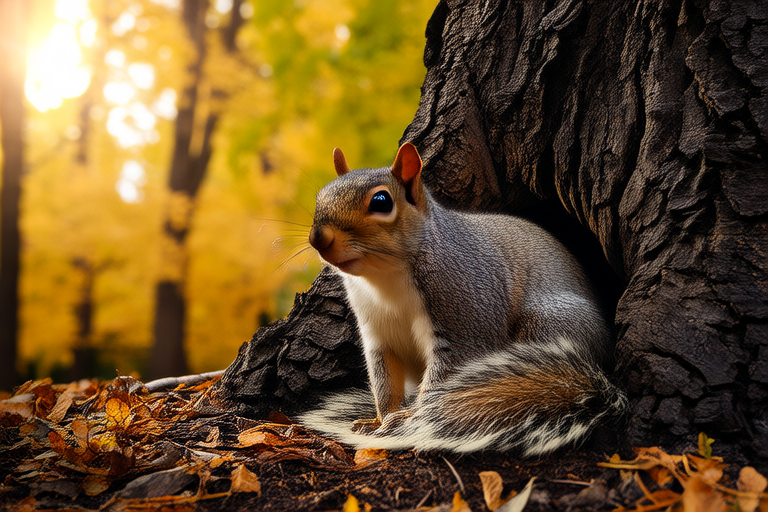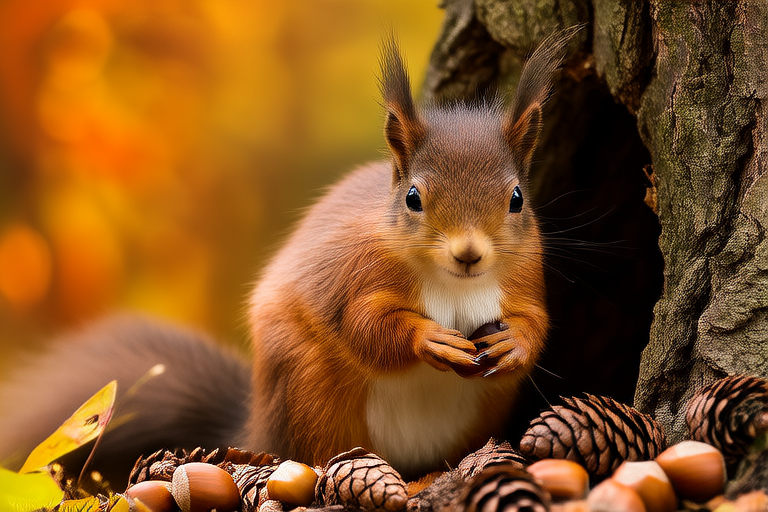
Urban Squirrels: The Secret Life of City Dwellers
In bustling urban environments, where skyscrapers tower over parks and concrete replaces forests, a resilient species thrives. These agile creatures, often overlooked, are urban squirrels. They have adapted remarkably well to city life, creating intricate social structures and utilizing various survival strategies. This article delves into their behaviors, habitats, and lesser-known facts, shedding light on their daily routines, communication methods, food gathering techniques, and the unique challenges and opportunities that urban living presents.
Habitats and Adaptations
Urban squirrels, primarily eastern gray squirrels (Sciurus carolinensis) and fox squirrels (Sciurus niger), have made cities their home by exploiting available resources. Their natural habitat consists of deciduous woodlands, but cities offer an abundance of trees, parks, and green spaces that mimic these environments. In urban areas, squirrels find refuge in parks, along tree-lined streets, and even within dense residential neighborhoods.
The adaptability of these animals is remarkable. They have learned to navigate complex cityscapes, scaling buildings, crossing busy roads, and avoiding predators. One of the most notable adaptations is their ability to thrive in fragmented habitats. Urbanization often results in isolated patches of greenery, but squirrels can traverse these barriers with ease, using power lines and fences as bridges. This mobility allows them to access a wider range of resources, increasing their chances of survival.
Daily Routines and Social Structures
A day in the life of an urban squirrel begins early. As dawn breaks, they emerge from their nests—often hollowed-out tree trunks or constructed leaf nests—to search for food. Their daily routine revolves around foraging, which typically takes up a significant portion of their waking hours. Squirrels are diurnal, meaning they are most active during the day, particularly in the morning and late afternoon. However, in heavily populated areas, they may adjust their activity patterns to avoid human interference.
Socially, urban squirrels are solitary creatures, with each individual staking out its own territory. While they may interact with others for mating purposes, they generally prefer to keep to themselves. Males are territorial and will defend their space against intruders, marking their boundaries with scent glands located on their cheeks. Females, on the other hand, tend to be more tolerant of each other, especially when raising young. This social structure ensures minimal competition for resources while allowing for occasional collaboration when necessary.
Communication Methods
Urban squirrels communicate through a variety of vocalizations, body postures, and scent markings. Alarm calls are one of the most recognizable forms of communication. When threatened, they emit high-pitched chirps to alert others of potential danger. These calls can vary in pitch and duration, depending on the severity of the threat. For instance, a brief, sharp chirp might indicate a passing dog, while a prolonged, drawn-out call could signal the presence of a predator like a hawk.
Beyond vocalizations, squirrels also use body language to convey messages. Tail flicking, for example, is a common gesture used to express agitation or warning. When a squirrel feels threatened, it will rapidly flick its tail from side to side, a behavior that serves both as a visual deterrent and a way to dislodge insects or debris from its fur. Additionally, scent marking plays a crucial role in establishing and maintaining territories. By rubbing their scent glands against objects such as tree trunks or fence posts, squirrels leave behind chemical signals that define their boundaries and attract potential mates.
Food Gathering Techniques
Foraging is a vital aspect of an urban squirrel’s life, and they have developed efficient methods for locating and securing food. Acorns, nuts, seeds, fruits, and fungi form the bulk of their diet. During autumn, when these foods are abundant, squirrels engage in a behavior known as caching, where they bury surplus food for later consumption. This practice not only ensures a steady supply of nutrients throughout winter but also helps them survive periods of scarcity.
Caching requires both spatial memory and problem-solving skills. Squirrels must remember the locations of hundreds of caches, sometimes spanning several kilometers. They achieve this through a combination of visual cues, olfactory markers, and possibly even celestial navigation. Furthermore, they employ deceptive tactics to prevent other animals from stealing their stash. For instance, they may dig multiple holes without depositing any food, creating false caches that mislead potential thieves.
Survival Strategies in City Environments
Living in cities poses numerous challenges for squirrels, yet they have evolved ingenious ways to overcome them. One of the primary threats is traffic. To cross busy streets safely, squirrels have honed their timing and agility. They carefully assess the flow of traffic before darting across, often pausing mid-crossing to ensure no vehicles are approaching. This skill is particularly impressive given the high speeds at which city roads operate.
Predation is another concern in urban settings. Hawks, cats, and dogs all pose risks to squirrels. To mitigate these dangers, they have adopted defensive behaviors such as staying vigilant, remaining hidden, and utilizing complex escape routes. In addition to physical avoidance, squirrels rely on their acute senses to detect predators from afar. Their keen eyesight, sharp hearing, and sensitive whiskers allow them to respond swiftly to impending threats.
Unique Challenges and Opportunities
The urban environment presents both challenges and opportunities for squirrels. On one hand, it exposes them to new hazards such as pollution, artificial lighting, and human interference. On the other hand, it offers an abundance of resources, including supplementary food sources like bird feeders and compost piles. Human interaction can be both beneficial and detrimental. Some people intentionally provide food for squirrels, while others may unintentionally harm them through activities such as pesticide use or habitat destruction.
One interesting observation is the impact of urban heat islands on squirrel behavior. Cities tend to be warmer than surrounding rural areas due to the concentration of buildings, asphalt, and human activity. This phenomenon influences the thermoregulatory strategies of squirrels. During hot summer days, they seek cooler microhabitats, such as shaded areas beneath trees or in underground burrows. Conversely, in colder months, the higher temperatures in cities can help them conserve energy and reduce the need for hibernation.
Scientific Insights and Anecdotes
Research has revealed fascinating insights into the lives of urban squirrels. A study conducted by the University of California, Berkeley, found that urban squirrels exhibit higher levels of stress hormones compared to their rural counterparts. This heightened stress response is likely due to the constant exposure to noise, traffic, and human activity. Despite this, urban squirrels show remarkable resilience, with some populations thriving even in densely populated areas.
Anecdotal evidence further illustrates the intelligence and adaptability of these creatures. In one instance, a squirrel was observed using a plastic bottle cap as a tool to pry open a jar of peanut butter left outside by a well-meaning homeowner. Another story tells of a squirrel that repeatedly visited a park bench, leaving behind acorns for a regular visitor who had fed it in the past. These examples highlight the complex cognitive abilities and social bonds that exist within urban squirrel communities.
Conclusion
Urban squirrels are fascinating creatures that have successfully adapted to city life. Through their daily routines, social structures, communication methods, and food gathering techniques, they demonstrate remarkable resilience and ingenuity. While urbanization presents challenges, it also offers opportunities for these resourceful animals. Understanding the secret life of urban squirrels not only enriches our appreciation of wildlife but also underscores the importance of preserving green spaces within our cities.





